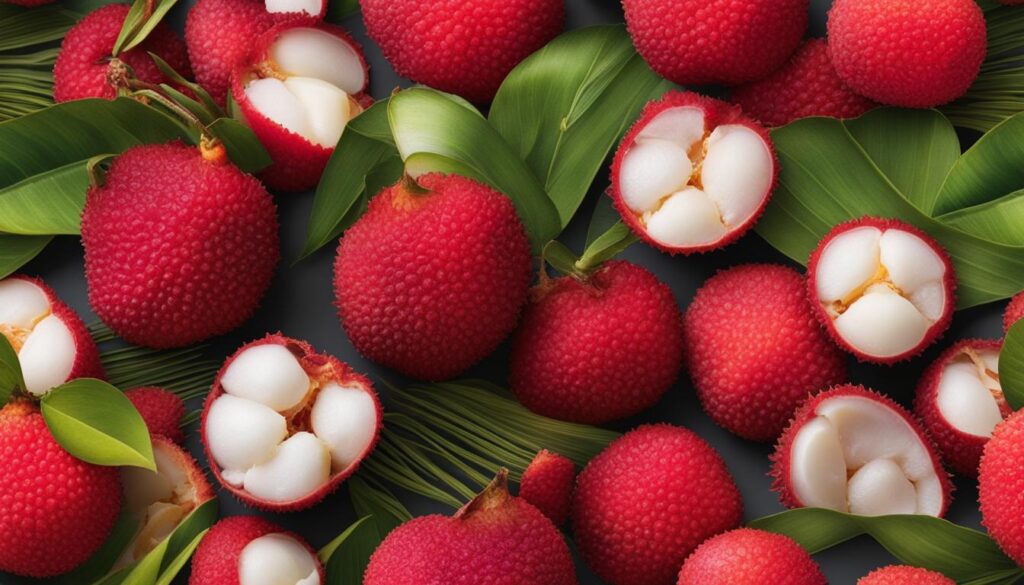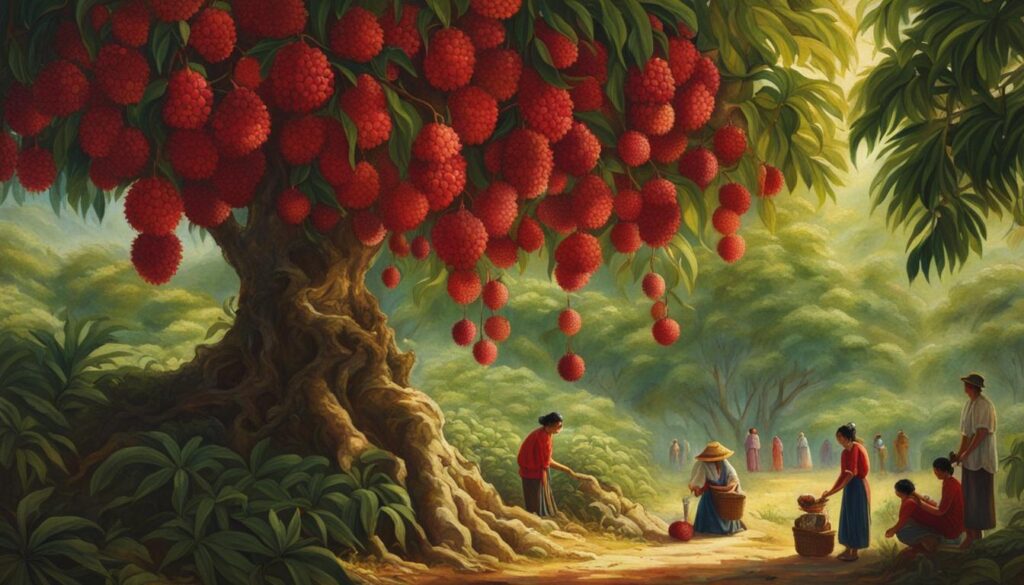Physical Address
304 North Cardinal St.
Dorchester Center, MA 02124
Physical Address
304 North Cardinal St.
Dorchester Center, MA 02124

Embark on a historical journey to uncover the origins of the exotic lychee. Our exploration begins with Lychee: A Comprehensive Guide, providing a thorough backdrop on this intriguing fruit. To understand its place in the wider tropical fruit spectrum, consider our Comparison of Lychee with Other Tropical Fruits. While appreciating lychee’s rich history, explore its Nutritional Benefits to see how its past has shaped its healthful present. Further, our insights into Longans and Lychees offer a glimpse into the evolutionary journey of lychees alongside their botanical cousins.
The origin of lychee can be traced back over 2,000 years to ancient China, where it held immense significance in the imperial courts. Admired for its luscious taste and symbolic of luxury and abundance, lychee gradually made its way beyond the borders of China, spreading its roots to new regions along the historic Silk Road. This ancient trade route acted as a conduit, introducing lychee to lands like India, the Middle East, and the Mediterranean.
Today, lychee is cultivated in several countries, with China taking the lead as its largest producer. Other notable lychee-growing nations include India, Thailand, and Vietnam. Each region brings its own unique touch to the cultivation of this delectable fruit, enriching the diversity of flavors and cultivars worldwide.
So, come along as we uncover the fascinating history of lychee, from its humble beginnings in ancient China to its global acclaim. Let’s explore the cultivation techniques, the journey along the Silk Road, and the culinary uses that have made lychee a favorite among fruit enthusiasts worldwide.
The Silk Road played a vital role in the spread of lychee cultivation across different regions. Traders and travelers carried the seeds and saplings of the lychee tree along the Silk Road, introducing the fruit to new lands and cultures. The allure of the sweet and exotic fruit captivated the taste buds of people along the Silk Road, leading to a growing demand for lychee in distant lands. This trade route facilitated cultural exchange and the enrichment of culinary traditions in regions like India, the Middle East, and the Mediterranean.
As the lychee spread along the Silk Road, it became a valuable commodity, traded alongside other goods and spices. The favorable climate and fertile soils of these regions provided ideal conditions for lychee cultivation. As a result, lychee orchards began to flourish along the trade routes, establishing a network of production and distribution.
The trading routes of the Silk Road allowed lychee to reach far-flung destinations, extending its reach into Southeast Asia and eventually the Americas. This expansion of lychee cultivation and trade not only contributed to the economic prosperity of the regions involved but also led to the exchange of ideas and cultural influences.
The Silk Road played a transformative role in the history of lychee cultivation. From its humble origins in China, lychee spread across vast distances, adapting to new climates and becoming an integral part of the culinary traditions of various cultures. The trade and cultural interactions along the Silk Road shaped the way lychee is grown, consumed, and valued to this day.

| Region | Lychee Production |
|---|---|
| China | Largest producer of lychee |
| India | Significant lychee cultivation |
| Thailand | Major exporter of lychee |
| Vietnam | Lychee production for domestic and export markets |
Today, the impact of the Silk Road can still be seen in the global lychee market. China remains the largest producer of lychee, followed by countries like India, Thailand, and Vietnam. The cultivation of lychee continues to thrive in these regions, with farmers utilizing both traditional and modern techniques to maximize yield and quality.
The journey of lychee along the Silk Road brought this delectable fruit to the world, sparking a love affair with its unique flavor and aroma. From its ancient origins to its modern-day cultivation and global popularity, lychee’s story is one of resilience, adaptation, and the power of trade routes to shape culinary traditions.
Lychee cultivation techniques have undergone significant evolution over the centuries, adapting to the changing needs and challenges of growers. Traditional cultivation methods, rooted in ancient Chinese practices, have gradually transitioned to modern techniques that focus on sustainability and productivity.
In ancient China, lychee cultivation required meticulous land selection, hand pollination, and protection against frost and pests. These practices ensured optimal growing conditions and high-quality fruit production. However, as lychee cultivation spread to different regions and faced new environmental conditions, cultivation techniques had to adapt.
Modern cultivation practices incorporate advanced technologies and scientific knowledge to enhance yields and minimize environmental impact. Growers now utilize efficient irrigation systems that conserve water and optimize nutrient delivery. Integrated pest management techniques help control pests while reducing reliance on harmful chemicals. Additionally, specialized fertilizers are employed to provide the necessary nutrients for healthy tree growth and fruit development.
With increasing emphasis on sustainable agriculture, many lychee growers are adopting organic farming methods. These practices prioritize soil health and biodiversity, minimize synthetic inputs, and promote ecological balance. Organic farming techniques such as composting, cover cropping, and biological pest control help maintain a harmonious ecosystem within lychee orchards.
The evolution of lychee cultivation techniques not only improves productivity but also safeguards the long-term viability of the industry. By embracing sustainable and organic practices, growers are proactively addressing environmental concerns and consumer demands for healthier and more eco-friendly food options.
Table: Comparison of Traditional and Modern Lychee Cultivation Techniques
| Traditional Techniques | Modern Techniques | |
|---|---|---|
| Land Selection | Emphasis on suitable soil type, drainage, and sunlight | Advanced soil analysis and land suitability assessments |
| Pollination | Manual hand pollination | Natural pollination supplemented by beekeeping and beneficial insect habitats |
| Pest Control | Reliance on manual pest removal and natural remedies | Integrated pest management strategies, including biological controls and targeted pesticide applications |
| Fertilization | Application of organic matter and traditional fertilizers | Specialized fertilizers tailored to lychee tree nutrient requirements |
| Water Management | Reliance on natural rainfall | Advanced irrigation systems with water-saving technologies |
The table above provides a comparison of the key differences between traditional and modern lychee cultivation techniques. It highlights the advancements in land selection, pollination, pest control, fertilization, and water management that have contributed to improved productivity and sustainability in the industry.

The journey of lychee from its origins in China to becoming a globally recognized fruit is a testament to its popularity and unique flavor. As trade routes expanded and explorers ventured into new territories, lychee found its way beyond the borders of China, spreading its cultivation to different countries around the world.
Led by China, countries like Thailand, Vietnam, and South Africa have embraced lychee cultivation and become major players in its production. These countries have favorable climates and suitable growing conditions, allowing them to cultivate lychee successfully. In addition to these traditional lychee-growing regions, other countries such as Australia, Brazil, and the United States have also started growing lychee to meet the growing demand.
Lychee has gained popularity in international markets due to its unique taste, juicy texture, and exotic appeal. It is not only enjoyed fresh but is also used in various culinary applications. The sweet and tangy flavor of lychee makes it a favorite ingredient in desserts, beverages, and savory dishes. Its vibrant red color and aromatic fragrance make it visually appealing and enhance the overall dining experience.
Lychee is a versatile fruit that can be consumed in multiple ways. It is commonly eaten fresh, with its juicy flesh providing a refreshing and delectable experience. In addition to being eaten as a whole fruit, lychee is often used in salads, smoothies, cocktails, and as a topping for ice cream and cakes.
The distribution of lychee has expanded to supermarkets, grocery stores, and specialty food markets worldwide. Lychee is typically available during the summer season when it is harvested. With the advancement of transportation and logistics, lychee can now be easily transported from cultivation regions to different parts of the world, allowing consumers to enjoy this exotic fruit regardless of their location.
| Country | Lychee Cultivation | Lychee Culinary Uses | Distribution |
|---|---|---|---|
| China | Large-scale production, leading lychee cultivation | Fresh consumption, desserts, beverages | Nationwide distribution, exported globally |
| Thailand | Significant lychee cultivation, renowned for sweet varieties | Traditional Thai desserts, tropical fruit salads, cocktails | Domestic distribution, exported to neighboring countries |
| Vietnam | Increasing lychee production, diverse cultivars | Lychee jelly, preserved lychee, lychee-infused drinks | Domestic distribution, exported to Asia and Europe |
| United States | Florida, Hawaii, and California are major lychee-growing states | Lychee-infused craft beers, lychee-inspired desserts, tropical cocktails | Regional distribution, available in specialty stores |
As lychee continues to gain popularity globally, its cultivation and distribution networks are expected to expand further. This will provide even more opportunities for people to experience the unique taste and versatility of lychee in their culinary adventures.
In conclusion, the origin of lychee can be traced back to ancient China, where it was highly esteemed in the imperial courts. Through the Silk Road, the cultivation of lychee spread to regions like India, the Middle East, and the Mediterranean, captivating people with its sweet and exotic flavor.
Over time, cultivation techniques have evolved, incorporating modern practices that focus on sustainable farming and organic methods. Today, lychee is grown in countries such as China, India, Thailand, and Vietnam, with China being the largest producer. Its global expansion has seen it reach international markets, where it is not only enjoyed fresh but also used in diverse culinary applications.
The journey of lychee from its humble beginnings to its widespread recognition highlights its cultural significance and culinary appeal. It is a fruit that has transcended borders, enriching culinary traditions and captivating taste buds around the world. With its rich history, global expansion, and continued importance, lychee remains a beloved fruit that embodies luxury, abundance, and the exotic flavors of the East.
Lychee has its origins in ancient China, where it has been cultivated for over 2,000 years.
The cultivation of lychee spread along the Silk Road, introducing the fruit to new regions such as India, the Middle East, and the Mediterranean.
Lychee is now grown in countries like China, India, Thailand, and Vietnam, with China being the largest producer.
Over the centuries, lychee cultivation techniques have evolved from traditional methods to modern practices that enhance yield and quality.
Yes, many growers are adopting sustainable farming practices, including organic farming methods and innovative approaches to pest control and soil management.
Lychee is cultivated in various countries worldwide, including Thailand, Vietnam, and South Africa, and its popularity has spread to international markets.
Lychee is enjoyed fresh and is also used in various dishes around the world, adding a touch of exotic sweetness.

I’m Rachel Cooper, the brain and heart behind AboutWeirdFruits. If you’re here, you probably share the same insatiable curiosity for the fascinating world of exotic fruits that I do. From the spiky Durian to the unique Buddha’s Hand, I’ve been captivated by the diversity, flavors, and benefits these rare fruits bring into our lives.